Question 1.
Match the following:
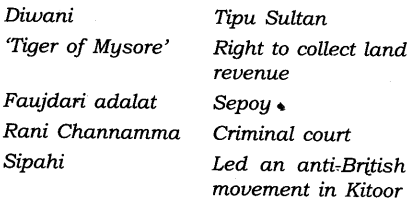
Answer:
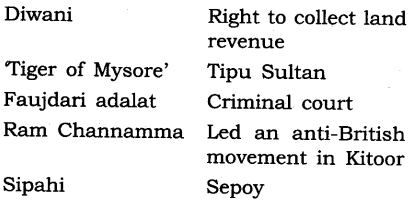
Question 2.
Fill in the blanks:
- (a) The British conquest of Bengal began with the Battle of …………
- (b) Haider All and Tipu Sultan were the rulers of …………..
- (c) Dalhousie implemented the Doctrine of ……………
- (d) Maratha kingdoms were located mainly in the part of …………… India.
Answer:
- (a) Plassey
- (b) Mysore
- (c) Lapse
- (d) Western
Question 3.
State whether true or false:
- (a) The Mughal empire became stronger in the eighteenth century.
- (b) The English East India Company was the only European company that traded with India.
- (c) Maharaja Ranjit Singh was the ruler of Punjab.
- (d) The British did not introduce administrative changes in the territories they conquered.
Answer:
- (a) False
- (b) False
- (c) True
- (d) False
Question 4.
What attracted European trading companies to India?
Answer:
European trading companies were attracted due to the following reasons:
- Cheap and fine quality of silk and cotton.
- For spices like pepper, cloves, cardamom and cinnamon etc.
Question 5.
What were the areas of conflict between the Bengal Nawabs and the East India Company?
Answer:
- The Bengal nawabs asserted their power and autonomy and refused to grant the Company concessions,
- They demanded large tributes for the Company’s right to trade,
- They denied the Company any right to mint coins,
- They stopped the Company from extending its fortifications
- Accusing the Company of deceit, they claimed that the Company was depriving the Bengal government of huge amounts of revenue and undermining the authority of the nawab. It was refusing to pay taxes, writing disrespectful letters, and trying to humiliate the nawab and his officials. These were the areas of conflict between the Bengal Nawabs and the East India Company.
Question 6.
How did the assumption of Diwani benefit the East India Company?
Answer:
The Mughal emperor, in 1765, appointed the Company’s the Diwan of the provinces of Bengal. The Diwani allowed the Company to exploit the vast revenue resources of Bengal. This solved a major problem that the company had earlier faced. Although its trade had expanded, it had to buy most of the goods in India with gold and silver imported from Britain. The overflow of gold from Britain stopped after the assumption of Diwani. Now revenue from India could finance Company expenses. These revenues they used to purchase cotton and silk textiles in India, maintain Company troops and meet the cost of building the Company fort and offices at Calcutta.
Question 7.
Explain the system of ‘subsidiary alliance’.
Answer:
Subsidiary Alliance System
- The Britishers as a supreme power: Whichever state wanted to sign this treaty, had to accept the English as a supreme authority. The East India Company behaved as a guardian of that state.
- Appointment of resident: The state kept an English Resident in their court,
to check the activities of the king.
- Keeping of an English army: Indian rulers were not allowed to have their army to protect the state from external and internal invasion. The state had to keep an English army. The state had to bear financial burden of the army.
- Giving to the territory: If the Indian rulers failed to make payments, part of their territories were taken away as penalty.
e.g.,
The Nawab of Awadh was forced to give over half of his territory to the company in 1801.
- Hyderabad was also forced to cede territories on similar grounds.
- Protection by the English: In return for the above-mentioned conditions the English Company promised to protect the state from its enemies. They also promised the state not to interfere in the internal affairs of the state but this was a promise they seldom kept.
Question 8.
In what way was the administration of the Company different from that of Indian rulers?
Answer:
The administration of the Company was different from that of the Indian rulers in the following ways:
- The Company divided its administrative units called Presidencies. There were three Presidencies – Bengal, Madras and Bombay. In India, districts were the main administrative units.
- Each presidency was ruled by a Governor. Districts were ruled by the Collectors.
- The supreme head of the administration of the Company was the Governor-General. But in India, the head of the administration was the king. .
- The main job of the Governor-General was to introduce administrative reforms while the main job of the Collector was to collect revenue and taxes- and maintain law and order in his district.
Question 9.
Describe the changes that occurred in the composition of the Company’s army.
Answer:
- East India Company adopted its own method when it began recruitment for the army.
- It was known as the sepoy army (from the Indian word sipahi, meaning soldier).
- With the change in warfare technology from the 1820s, the cavalry needs of the Company’s army declined, because the British empire was fighting in Burma, Afghanistan, and Egypt. There the soldiers were armed with muskets and matchlocks
- The soldiers had to keep pace with changing military requirements.
- Its infantry regiments now became more important.
- In the early 19th century the British began to develop a uniform military culture.
- Soldiers were given European-style training drills and discipline.
- They regulated their life far more than before.
- Often this created problems since caste and community feelings were ignored in building a force of professional soldiers.
Question 10.
After the British conquest of Bengal, Calcutta -grew from a small village to a big city. Find out about the culture, architecture, and the life of Europeans and Indians of the city during the colonial period.
Answer:
Hints: Visit the school library or get information from the internet.
Indians were influenced by British culture, architecture and lifestyle.
- Culture: British influence began.
- Architecture: Influenced by the British Architecture (fortification of the city, churches, etc.). Rich Indians started constructing bungalows in the English style.
- Life: English education, English clothes, became to be popular.
Question 11.
Collect pictures, stories, poems, and information about any of the following – the Rani of Jhansi, Mahadji Sindhia, Haidar Ali, Maharaja Ranjit Singh, Lord Dalhousie, or any other contemporary ruler of your region.
Answer:
The Rani of Jhansi: Collect information and photographs
Hints:
- Early childhood
- Early marriage
- Death of husband
- Adopted son
- Fight with British
- Died fighting with the British.
- History would always remember her.
1. Rani of Jhansi:
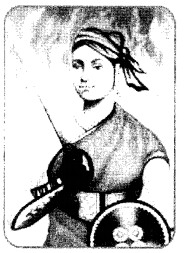
Lakshmibai was born probably on 19 November 1828 in the holy town of Varanasi in a Marathi brahmin family. Her father was Moropant Tambe. Her father worked for a court of Peshwa of Bithoor district. Peshwa brought Manikarnika up like his own daughter. The Peshwa called her “Chhabili”, which means “playful”.
She was educated at home and was more independent in her childhood than others of her age; her studies included archery, horsemanship, and self-defense.
Rani Lakshmibai was accustomed to ride on horseback accompanied by a small escort between the palace and the temple. The Rani Mahal, the place of Rani Lakshmibai, has now been converted into a museum. She died, fighting British Army bravely, to save her state Jhansi.
2. Mahadaji Shindhia
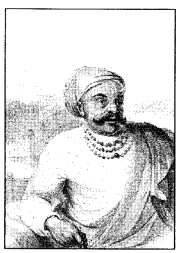
Mahadaji Shinde (1730-1794 A.D.) also spelled as Mahadji Scindia or Mahadaji Scindia, was a Maratha ruler of the state of Gwalior in central India.
Mahadaji was instrumental in resurrecting Maratha power in North India after the Third Battle of Panipat in 1761 and rose to become a trusted lieutenant of the Peshwa, leader of the Maratha Empire. During his reign, Gwalior became the leading state in the Maratha Empire and one of the foremost military powers in India.
He accompanied Shah Alarm II (Mughal Badshah) in 1771 to Delhi in order to restore the Mughals in Delhi. The Marathas were practically at that time ruling Delhi. He annihilated the power of Jats of Mathura and during 1772-73 and destroyed the power of Pashtun Rohillas in Rohilkhand and captured Najibabad. His role during the ‘First Anglo Maratha War was greatest from the Maratha side since he humbled the British in Central India, single-handed, which resulted in the Treaty of Salbai in 1782, where he mediated between the Peshwa and the British.
3. Hyder Ali Of Mysore
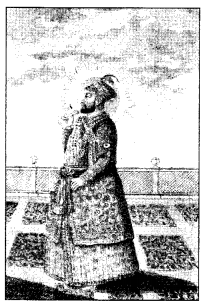
Hyder Ali (1721-1782) was the sultan and de facto ruler of the Kingdom of Mysore in southern India. Born Hyder Naik, he distinguished himself militarily, eventually drawing the attention of Mysore’s rulers. Rising to the post of Dalavayi (commander-in-chief) to Krishnaraja Wodeyar II, he came to dominate the titular monarch and the Mysore government. He became the de facto ruler of Mysore as Sarvadhikari (Chief Minister) by 1761. He offered strong anti-colonial resistance against the military advances of the British East’India Company during the First and Second Anglo Mysore Wars and he was the innovator of military use of the ‘iron-cased Mysorean rockets.
4. Maharaja Ranjit Singh
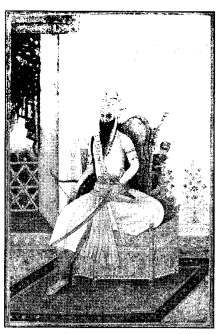
Ranjit Singh was born to Sardar Maha Singh and Raj Kaur on 13 November 1780, in Gujranwala, Punjab (now in Pakistan). As a child, he suffered from smallpox which resulted in the loss of one eye. At the time, much of Punjab was ruled by the Sikhs under a Confederate Sarbat Khalsa system, which had divided the territory among factions known as misls Ranjit Singh’s father was the commander of the Sukerchakia Misl and controlled a territory in west Punjab based around his headquarter at Gujranwala.
In 1799, Ranjit Singh captured Lahore (now in Pakistan) from the Bhangi Misl and later made it his capital. This was the first important step in his rise to power. In the following years, he brought the whole of central Punjab from the Sutlej to the Jhelum under his sway. This area includes north of Satluj (Jullundhar, Amritsar, Pathankot, etc.); and Lahore, Multan, etc. of Pakistan.
5. Lord Dalhousie
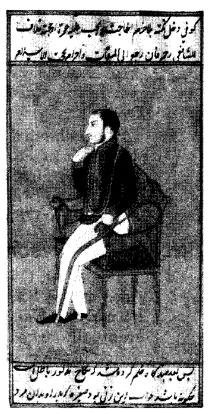
Governor-general of India (1848 to 1856): Lord Dalhousie is one the most negatively remembered personality in the rule of East India Company. He ruled India with his full efficiency from 1848 to 1856 A.D. In India, he was famous for various negative and positive reasons.
Positive:
- Starting of Railway in 1853 A.D. for the first time, between Bombay to Thane.
- Starting with postal and telegraph services in India.
- Starting with widow remarriage in 1856 A.D.
- Completion of Ganges Canal.
- Reform in Indian civil services.
Negative
- East India Company captured the princely state of Punjab in 1849 A.D.
- Second Anglo-Burmese War.
- Doctrine of Lapse (Most Controversial).
- Annexation of Awadh.